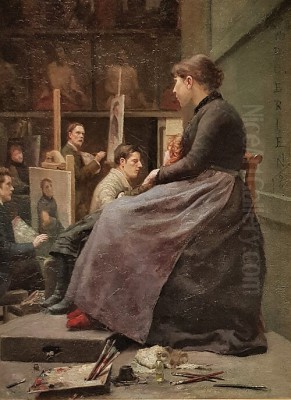
Dermod O'Brien, a name synonymous with a pivotal era in Irish art, stands as a significant figure whose contributions extended beyond the canvas into the very fabric of Ireland's cultural and institutional life. Born in 1865 and passing away in 1945, O'Brien's life spanned a period of immense artistic and political transformation in Ireland. He was not only a painter celebrated for his evocative landscapes and insightful portraits but also a distinguished administrator, most notably serving as the President of the Royal Hibernian Academy for an unprecedented thirty-five years. His legacy is one of artistic dedication, institutional leadership, and a profound engagement with the evolving identity of his nation.
Early Life and Formative Influences
William Dermod O'Brien was born on June 10, 1865, at Mount Trenchard House, Foynes, County Limerick, into a family with a storied Irish lineage. He was the son of Edward William O'Brien and Julia Mary (née Marshall). His paternal grandfather was William Smith O'Brien, the prominent Young Irelander and nationalist leader, a fact that undoubtedly cast a long shadow and perhaps instilled a deep, albeit complex, sense of Irish identity. Following the early death of his mother, and his father's subsequent remarriage and move to England, young Dermod and his siblings were raised by their aunt, Charlotte Grace O'Brien, a noted philanthropist, writer, and advocate for emigrants. This upbringing at Cahirmoyle, County Limerick, the family estate inherited by his father, likely provided a stable yet intellectually stimulating environment.
Charlotte Grace O'Brien's own strong character and social conscience may have influenced Dermod's later public service. The O'Brien family's connection to the land and Irish heritage was profound, and this grounding in the Irish landscape would later manifest powerfully in his artistic output. His early education was typical for his class, including schooling at Harrow School in England, which provided a classical foundation before he embarked on his artistic journey.
Artistic Training: A European Pilgrimage
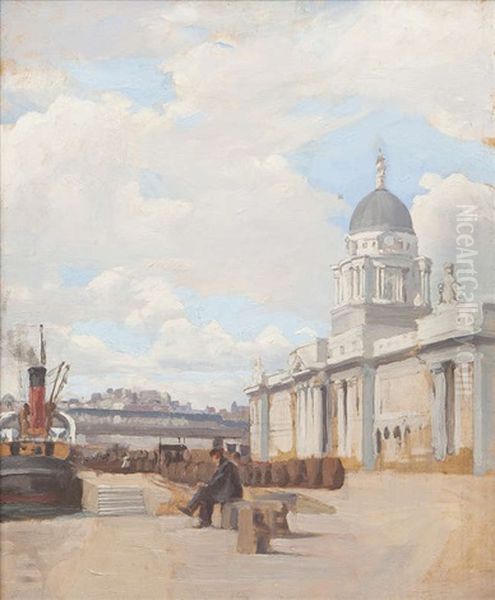
O'Brien's formal artistic education began in the late 1880s, a period when aspiring artists often sought training on the European continent. He initially spent time copying works at the Louvre in Paris, a traditional method for art students to immerse themselves in the techniques of the Old Masters. His pursuit of academic rigor then led him to Antwerp, Belgium, where he enrolled at the Royal Academy of Fine Arts. Antwerp was a significant centre for academic art training, attracting students from across Europe. Here, he would have been immersed in a curriculum that emphasized strong draughtsmanship, anatomical study, and the classical principles of composition. It was in Antwerp that he encountered fellow Irish artist Walter Osborne, with whom he formed a lasting friendship and shared a commitment to plein air painting and a naturalistic depiction of light and atmosphere.
Following his time in Antwerp, O'Brien moved to Paris, the undisputed epicentre of the art world at the time. He studied at the Académie Julian, a renowned private art school that offered a more liberal alternative to the official École des Beaux-Arts. The Académie Julian was particularly popular with foreign students and was known for its life drawing classes and critiques from established academic painters. This period in Paris would have exposed O'Brien to a vibrant artistic milieu, where Impressionism had already made its mark and Post-Impressionist movements were beginning to emerge. Artists like William Rothenstein and Charles Conder were among his contemporaries there.
His educational journey also included a period at the Slade School of Fine Art in London. The Slade, under figures like Alphonse Legros and later Henry Tonks, was becoming a progressive force in British art education, emphasizing drawing from life and fostering a generation of talented artists, including Augustus John and William Orpen. This comprehensive training across different European art centres equipped O'Brien with a versatile skill set and a broad understanding of both traditional and contemporary artistic currents, though his own style would remain rooted in a form of academic realism.
Return to Ireland and Artistic Style
In 1901, Dermod O'Brien made the significant decision to move to Dublin, establishing himself as a professional artist in his homeland. This move coincided with a period of intense cultural nationalism in Ireland, often referred to as the Irish Renaissance or Celtic Revival, which saw a flourishing of literature, theatre, and art focused on Irish themes and identity. While O'Brien's style was not overtly nationalistic in the manner of some Celtic Revival artists, his dedication to depicting the Irish landscape and its people contributed to this broader cultural awakening.
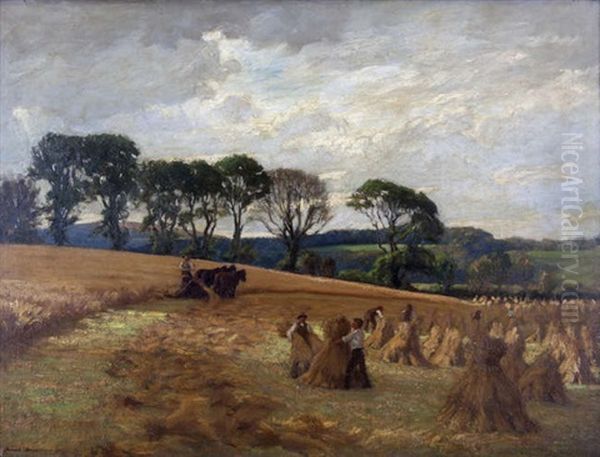
O'Brien's artistic style is characterized by its meticulous realism, strong draughtsmanship, and a subtle, considered use of colour. He was primarily known for his landscapes and portraits. His landscapes often capture the specific light and atmosphere of the Irish countryside, rendered with a keen observational eye and a deep appreciation for the nuances of nature. Unlike the more romanticized or stylized depictions of Ireland by artists like Paul Henry, O'Brien's landscapes possess a quiet dignity and a faithful representation of place. His brushwork is generally controlled and precise, building up form and texture with care.
In his portraiture, O'Brien demonstrated an ability to capture not only a physical likeness but also a sense of the sitter's character. His portraits are often formal yet imbued with a sensitivity that reveals his connection to the subject. He painted numerous prominent figures of his time, and these works serve as valuable historical documents as well as artistic achievements. His approach remained largely consistent throughout his career, adhering to the academic principles he had absorbed during his training, even as more radical modernist movements gained traction in Europe and, to a lesser extent, in Ireland.
Representative Works
Several paintings stand out as representative of Dermod O'Brien's oeuvre. "The Customs House, Dublin" is a notable example of his urban landscape work. This oil on board painting, measuring 46 x 38.5 cm, depicts the iconic Dublin landmark with a careful attention to architectural detail and atmospheric conditions. The work was notably featured on the cover of an exhibition catalogue for the Cynthia O'Connor Gallery in 1983, indicating its perceived importance within his body of work. It showcases his ability to handle complex structures and to convey the grandeur of civic architecture within a naturalistic setting.
Another significant work is "Heading the Stooks," a landscape painting that exemplifies his engagement with rural Irish life and scenery. The composition is often described as compact, with a thoughtful use of colour that emphasizes the textures and details of the harvest scene. This painting reflects his interest in the agrarian rhythms of the Irish countryside, a theme that resonated with many Irish artists of the period who sought to capture the essence of Irish life.
"Place de L'Eglise, Montreuil," painted in 1925, demonstrates his continued connection to the European continent and his skill in capturing the charm of continental townscapes. This work likely reflects his earlier experiences studying and painting in France, showcasing a similar attention to light and architectural form as seen in his Irish subjects.
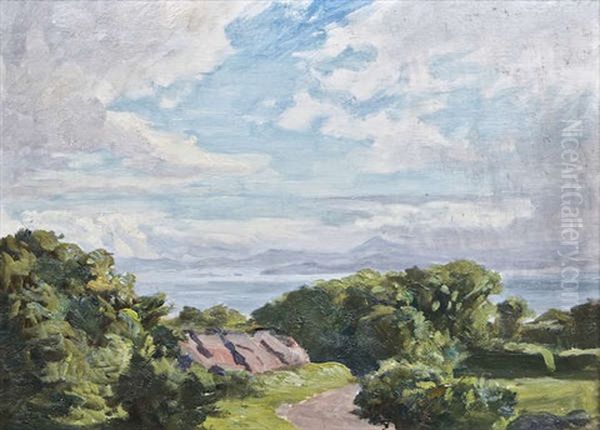
"Across The Bay From Howth Head" (25 x 34 cm) is another example of his landscape painting, likely capturing a coastal scene with his characteristic fidelity to nature. Such works highlight his ability to convey the expansive vistas and changing moods of the Irish coastline. His body of work, though perhaps not as widely known internationally as some of his more avant-garde contemporaries, forms a solid and respected contribution to Irish art of the early 20th century.
The Royal Hibernian Academy and Institutional Leadership
Dermod O'Brien's most enduring public role was undoubtedly his presidency of the Royal Hibernian Academy (RHA). He was elected President in 1910 and held this prestigious position for an extraordinary thirty-five years, until his death in 1945. The RHA, founded in 1823, was and remains the preeminent institution for academic art in Ireland. As its President, O'Brien wielded considerable influence over the direction of Irish art, particularly in terms of exhibition opportunities and the upholding of academic standards.
His long tenure coincided with a period of significant change and challenge for the RHA. The early 20th century saw the rise of modernist art movements that often stood in opposition to academic traditions. O'Brien, while a traditionalist himself, had to navigate these evolving artistic currents. He oversaw the RHA's annual exhibitions, which were major events in the Irish cultural calendar, providing a platform for established and emerging artists. Figures like John Butler Yeats, William Orpen, and later, even artists with more modern sensibilities such as Mainie Jellett and Evie Hone, exhibited at the RHA, though Jellett and Hone were more closely associated with the avant-garde Irish Exhibition of Living Art.
O'Brien's leadership was crucial in maintaining the RHA's stability and relevance during turbulent times, which included the First World War, the Irish War of Independence, and the early years of the Irish Free State. He was known for his dedication, administrative skill, and his commitment to the welfare of artists. His deep involvement with the RHA made him a central figure in the official art world of Ireland for over three decades. He was also instrumental in organizing the Oireachtas art exhibitions, further promoting Irish art and artists.
Public Life and Cultural Contributions
Beyond his RHA presidency, Dermod O'Brien was actively involved in various aspects of Irish public and cultural life. He served as a Governor of the National Gallery of Ireland, contributing his expertise to the stewardship of the nation's art collection. This role, alongside his RHA presidency, positioned him at the heart of Ireland's artistic establishment.
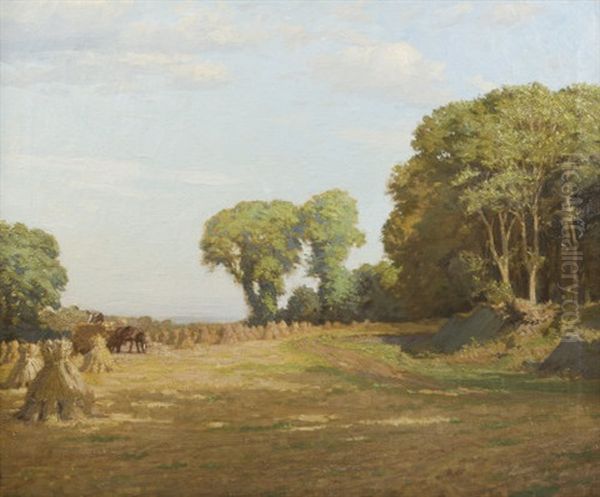
O'Brien was a staunch supporter of Sir Horace Plunkett's co-operative movement. This movement aimed to improve the economic conditions of rural Ireland through the establishment of agricultural co-operatives. O'Brien's involvement reflected a practical concern for the welfare of the Irish people, particularly those in agricultural communities, which he so often depicted in his landscapes. His support for this movement aligned with a broader ethos of self-help and community development that was gaining traction in Ireland at the time.
A unique and lasting contribution was his design for the "Ploughman" series of banknotes for the Irish Free State in the 1920s. These banknotes, featuring an archetypal Irish ploughman with his horses, became iconic symbols of the new state and its agricultural heritage. O'Brien's design was widely praised for its artistry and its resonant imagery, connecting the currency of the nation to the land and its people. This commission underscored his status as a respected national artist.
His political affiliations included support for the Irish Unionist Alliance and later the Liberal Unionist Party, which might seem at odds with his grandfather's nationalist legacy. However, Irish political identities were complex, and many Anglo-Irish figures sought to contribute to Ireland's welfare within the existing political structures or through a more gradual, conciliatory approach to political change. During the First World War, O'Brien served as a Deputy Inspector-General of the Royal Irish Constabulary for County Limerick. He also joined the Irish Volunteers, though this was likely the National Volunteers who supported the British war effort, rather than the Irish Volunteers who would later participate in the Easter Rising. These activities reflect a commitment to public service and order during a tumultuous period.
Contemporaries and the Artistic Milieu
Dermod O'Brien's career unfolded within a vibrant and diverse Irish artistic milieu. His early studies in Antwerp alongside Walter Osborne cemented a key artistic relationship. Osborne, who tragically died young in 1903, was a highly talented painter whose work, like O'Brien's, was characterized by its sensitive depiction of light and everyday life.
As President of the RHA, O'Brien interacted with a wide range of artists. These included established figures like the portraitist Sarah Purser, who was also a major cultural force in Dublin, founding An Túr Gloine, a stained-glass cooperative. Other prominent RHA members during his tenure included Sir John Lavery and Sir William Orpen, both of whom achieved international fame as portrait painters. While Orpen had a more flamboyant style and personality, he, like O'Brien, had a strong academic grounding.
The Irish art scene was not monolithic. While O'Brien represented a more traditional, academic approach, other artists were exploring modernism. Mainie Jellett and Evie Hone, for instance, studied under André Lhote and Albert Gleizes in Paris and became pioneers of Cubism and abstract art in Ireland. Although their artistic philosophies differed from O'Brien's, they still engaged with institutions like the RHA to some extent, and O'Brien, in his institutional capacity, would have been aware of these emerging trends. His sister, Brigid Ganly, and his wife, Katherine "Kitty" Wilmer O'Brien (née Todhunter), were also artists, creating a familial artistic environment. Kitty was a respected portrait and landscape painter in her own right.
The broader landscape of Irish art included figures like Nathaniel Hone the Younger, a generation older than O'Brien, whose atmospheric landscapes were highly influential, and Paul Henry, whose iconic depictions of the West of Ireland shaped a particular vision of Irish identity. Jack B. Yeats, brother of the poet W.B. Yeats, developed a highly individualistic, expressionistic style that stood in stark contrast to O'Brien's academic realism but became one of the most celebrated representations of Irish life. O'Brien's friendship with the playwright and Abbey Theatre director Lennox Robinson highlights his connections to the wider Irish cultural revival, which encompassed literature and theatre as well as the visual arts.
Exhibitions and Recognition
Dermod O'Brien's work was regularly exhibited throughout his career, both in Ireland and internationally. He was a consistent exhibitor at the Royal Hibernian Academy from 1906, showcasing his latest landscapes and portraits to the Irish public. His work also travelled further afield. In 1913 and 1915, he exhibited at the RHA. Records show him exhibiting at the Royal Scottish Academy in 1915 and, significantly, at the Boston Museum of Fine Arts in the same year, indicating a degree of international recognition.
His paintings continued to be exhibited after his death. Posthumous showings included exhibitions at the Cork ROSC (Rosc Chorcaí) in 1950 and 1976, and at the Dawson Gallery in Dublin in 1945 (likely a memorial exhibition) and 1946. The Dawson Gallery was an important venue for Irish art during this period. His works, such as "Heading the Stooks" (1913) and "Across The Bay From Howth Head," have appeared in important Irish art auctions, for example, at ADAM'S "Important Irish Art" sale in 2013, demonstrating continued collector interest.
His role as an expert advisor for the Gibson Bequest Committee for the Crawford Art Gallery in Cork further illustrates his respected standing in the art world, entrusted with recommending acquisitions. The extensive "Papers of the Family of O'Brien of Cahirmoyle, Co. Limerick," held in the National Library of Ireland, contain valuable material relating to his life and career, including exhibition catalogues and art publications, providing rich resources for researchers.
Legacy
Dermod O'Brien's legacy is multifaceted. As a painter, he left behind a substantial body of work that captures the landscapes and people of Ireland with skill and sensitivity. While his style remained rooted in academic tradition, his dedication to his craft and his keen observational abilities ensured the lasting quality of his paintings. He provided a steady, conservative counterpoint to the more radical artistic experiments of some of his contemporaries, and in doing so, helped to maintain a continuity of representational art in Ireland.
His most significant impact, however, may lie in his institutional leadership. His thirty-five-year presidency of the Royal Hibernian Academy was a remarkable feat of endurance and dedication. He guided the RHA through periods of political upheaval and artistic change, ensuring its survival and continued importance as a central institution in Irish artistic life. His work for the National Gallery of Ireland and his influential design of the Ploughman banknotes further solidified his role as a key figure in the cultural establishment of his time.
Dermod O'Brien was a man of his class and era, embodying a sense of duty and public service. His contributions to Irish art, both as a creator and an administrator, were profound. He helped to shape the artistic landscape of Ireland in the first half of the 20th century, and his work continues to be appreciated for its quiet integrity and its faithful depiction of a changing Ireland. He remains an important figure for understanding the complexities of Irish art and culture during a formative period in the nation's history.